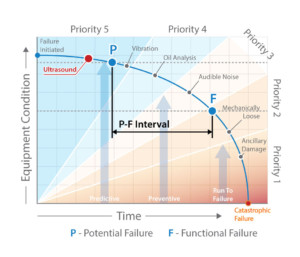What Is Ultrasound And How Can It Help With Your Condition Monitoring Program
 Imagine being able to listen to assets. I don’t mean the old trick of holding a screwdriver to a bearing housing, but actually being able to hear the rolling elements of a bearing. What about being able to record the audio sample, analyze and trend the information? All of this is now possible with the Ultrasound technology currently available.
Imagine being able to listen to assets. I don’t mean the old trick of holding a screwdriver to a bearing housing, but actually being able to hear the rolling elements of a bearing. What about being able to record the audio sample, analyze and trend the information? All of this is now possible with the Ultrasound technology currently available.
Most of us have heard of using Ultrasound to find compressed air leaks, but Ultrasound condition monitoring has so much more to offer and has the ability to detect issues before Vibration Analysis and Thermal Imaging. But before we dive into the various applications of ultrasound, it is important to understand what ultrasound is and how it works.
Principles of Ultrasound
Ultrasound is a sound wave which is above the normal hearing range of humans (humans can hear between 20-20,000 Hz). The ultrasound wave is above 20,000 Hz (or 20 kHz). However, the most important frequency for Ultrasound condition monitoring is between the 36-40 kHz range.
An important aspect of ultrasound is amplitude. Amplitude is the change of a periodic variable over a single period. A period is the amount of time it takes for a waveform to perform a single cycle. What further complicates amplitude in ultrasound is that a decibel scale is used. The decibel scale is a ratio scale. That means that amplitude is not an absolute value, but instead, the measurement is a comparison against a reference point.
Also, it is important to note that the decibel scale is logarithmic. This means that for every 6 dB increase, there is essentially a doubling the amplitude, while an increase in 20 dB is an increase of 10x.
The material in which the ultrasound is being measured through also has an impact on the dB reading as well. Also, if the readings are taken through the air, it is vital to know the distance to the source of the ultrasound to ensure the readings are; i) consistent; ii) you can understand the true dB level. For example, if you double the distance between the ultrasound probe and the source, you would experience a decrease of 6dB (the opposite happens if you halve the distance).
The above is a very high-level overview of the principles of ultrasound.
Types of Ultrasound Sensors
Taking a proper ultrasound reading requires the user to select the right type of ultrasound sensor. There are four primary types of sensors available to be used with the SDT Ultrasound line of devices.
- Internal/External Sensors have limited range of operation regarding frequency and direction. This type of sensor is very directional and has a conical response. This type of sensor is ideal for general inspections.
- Parabolic Dishes are designed to be used to listen to equipment located further away. However, the parabolic dish does not have a conical response, and the size of the dish is the size of the listening area. Parabolic dishes should be used at distances >8m.
- Acoustic Horns are designed to provide a bit of amplification. This makes the acoustic horn ideal for increasing the low-level sources of ultrasound or being able to increase the distance to detect sources of ultrasound. The acoustic horn is a good in-between for the internal/external sensors and the parabolic dish.
- Contact Ultrasound Sensor is very similar to an accelerometer (for those involved with vibration analysis). These types of sensors are ideal not for finding compressed air leaks, corona, etc., but for monitoring bearing conditions, and acoustic lubrication.
To get the best readings and results from your Ultrasound program, selecting the right sensor is critical.
The above is a very high level overview of the principles and sensor types of ultrasound, and I highly encourage anyone interested in learning more to attend one of the world class Ultrasound courses by SDT International.
Remember, to find success; you must first solve the problem, then achieve the implementation of the solution, and finally sustain winning results.
I’m James Kovacevic
Eruditio, LLC
Where Education Meets Application
Follow @EruditioLLC
References;

